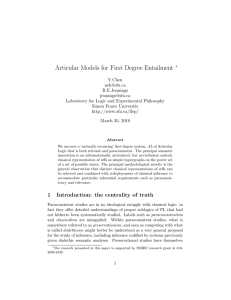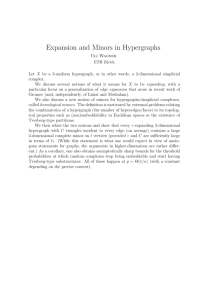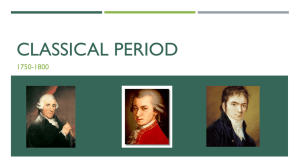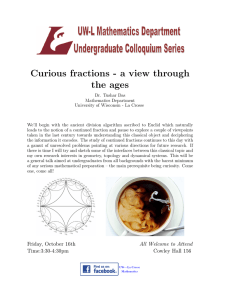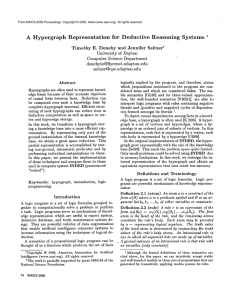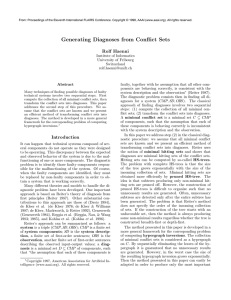Articular Logic
advertisement
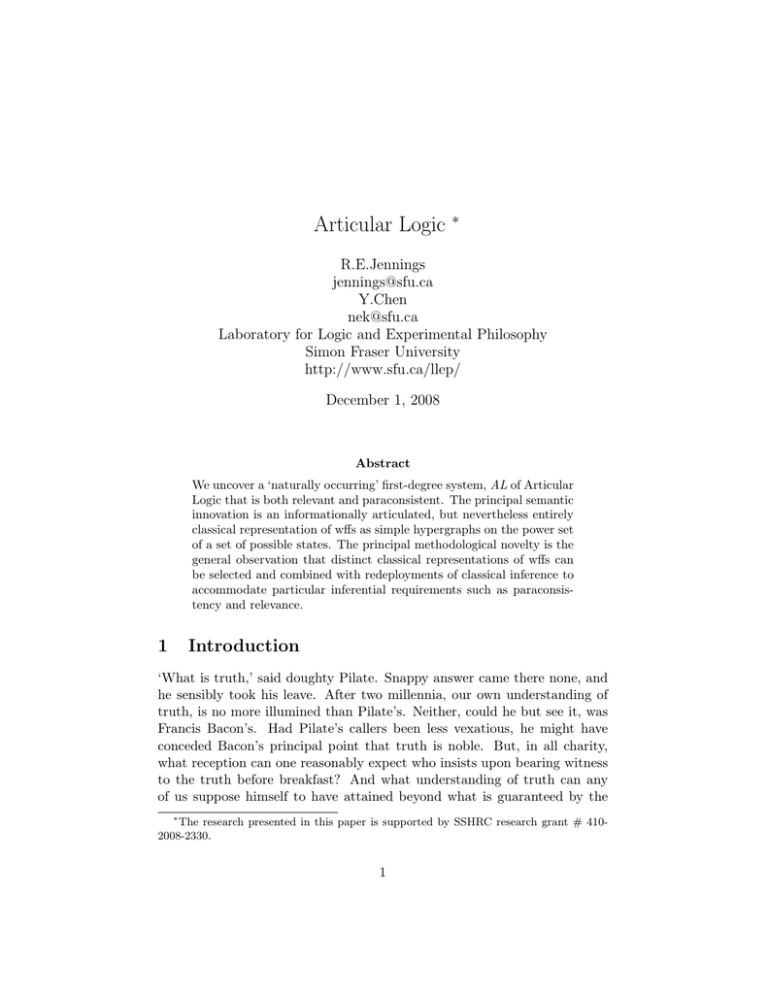
Articular Logic
∗
R.E.Jennings
jennings@sfu.ca
Y.Chen
nek@sfu.ca
Laboratory for Logic and Experimental Philosophy
Simon Fraser University
http://www.sfu.ca/llep/
December 1, 2008
Abstract
We uncover a ‘naturally occurring’ first-degree system, AL of Articular
Logic that is both relevant and paraconsistent. The principal semantic
innovation is an informationally articulated, but nevertheless entirely
classical representation of wffs as simple hypergraphs on the power set
of a set of possible states. The principal methodological novelty is the
general observation that distinct classical representations of wffs can
be selected and combined with redeployments of classical inference to
accommodate particular inferential requirements such as paraconsistency and relevance.
1
Introduction
‘What is truth,’ said doughty Pilate. Snappy answer came there none, and
he sensibly took his leave. After two millennia, our own understanding of
truth, is no more illumined than Pilate’s. Neither, could he but see it, was
Francis Bacon’s. Had Pilate’s callers been less vexatious, he might have
conceded Bacon’s principal point that truth is noble. But, in all charity,
what reception can one reasonably expect who insists upon bearing witness
to the truth before breakfast? And what understanding of truth can any
of us suppose himself to have attained beyond what is guaranteed by the
∗
The research presented in this paper is supported by SSHRC research grant # 4102008-2330.
1
successful transmission of conversational usage to small children? As Tarski
observed [4], ‘although the meaning of semantic concepts as they are used in
everyday language seems to be rather clear and understandable, still all attempts to characterize this meaning in a general and exact way miscarried.’
Being linguistic is, after all, a biological feature of humans, and biologically
the case is hopeless.
In logical uses, ‘truth’ is merely a reading for some abstractly defined notion
of satisfaction. In science it figures not even in grant applications. To be
sure one might speak usefully of true or false observational claims: that use
requires no more than conversational understanding, but the search for a
good physical theory is in part a search for a suitable theoretical language.
It is not merely a matter of checking truth-values of sentences in some language divinely vouchsafed. Moreover, although a theoretical claim might
be rejected on observational grounds, it can at best be compatible with observation, and a rejection is, as often as not, a rejection of the theoretical
language in which the claim is expressed.
Tarski again [4]: ‘the languages (either the formalized languages or – what
is more frequently the case – the portions of everyday language) which are
used in scientific discourse do not have to be semantically closed. This is
obvious in case linguistic phenomena and, in particular, semantic notions
do not enter in any way into the subject-matter of a science; for in such a
case the language of this science does not have to be provided with any semantic terms at all. . . Semantically closed languages can be dispensed with
even in those scientific discussions in which semantic notions are essentially
involved.’ Nevertheless, we do manage to express correct and incorrect inferences in theoretical languages.
Logicians of preservationist stripe are among those who have treated the
language of truth with a certain level of suspicion, and accordingly either
have sought mathematically well-defined properties of sets of data that inference can be required to preserve, or have hypothesized mathematically
distinguishable properties of truth, so that, at least one can specify what, for
particular cases, the preservation of truth requires. Such logicians have also
proposed representational innovations. A set of sentences can be represented
by the set of its narrowest countable partitions into consistent subsets, when
such a partition exists. For the purposes of this report, it is relevant to stress
only that such a representation is a classical one. It is, moreover, a classical representation designed to support an inference relation that preserves
2
a measure of coherence defined by that least width. Distinct classical representations can be more or less or merely differently informative.
The languages of the physical sciences differ from that of classical logic in
this respect: a theoretical sentence need not be wholly represented by the observational information that it implies. Nevertheless, a physical theory can
have a preservation-worthy status in virtue of its being highly confirmed,
perhaps even maximally confirmed, that is, when there remains only the
question as to whether its language will sufficiently discriminate future experimentally discriminable cases. We could then raise the question as to
what system of inference would preserve that status. The merit of such a
system of inference would be its dependence upon nothing but observable
truth, for which we might claim that conversational understanding was sufficient. Such a representation of a physical theory would be articular as we
use the term here. That is, a sentence would be represented by its articulation into its inferentially minimal observational subimplicates.
We do not present such an inference system here, though we do set out its
skeletal propositional realization. We perform one final duty before doing
so: to acknowledge that that more general idea has been approximated in
the history of philosophy. Anyone might come across it while scratching
about in the admirably friable oeuvre of Leibniz, for something leibnizian
that the great man almost said. There he would find the doctrine that all
truth is analytic, that the difference between necessary truth and contingent
truth is that necessary truths are finitely analytic whereas contingent truths
require infinite analysis, which only God can perform. Now Leibniz was
operating under the simplifying assumption that the sentences expressing
these truths are of SP form, a restriction unobserved in his own metatheoretic remarks. So the idea was that in the case of necessary truths, we will
encounter, in the course of an analysis of the concept represented in the subject term, a sufficiency of necessary ingredients for the concept represented
in the predicate term. For contingent truths, the ingredients required for
the concept represented in the predicate term are not to be revealed by any
finite analysis of the subject concept. Only God can effect such an analysis.
In consequence, contingent sentences can at best be confirmed by human
diligence; they cannot be verified.
Now Leibniz may have had in mind (or just beyond) that infinitesimals
were required for a complete understanding of the state of a physical system
since those physical states are in constant change. If so, no SP language
3
in a philosopher’s repertoire would be adequate even to approximations of
such expressive requirements. But in a simple-hearted first approximation
for a static condition, the case would be something like this: for a contingent
sentence α to obtain, infinitely many independent proper sub-implications,
β of α have to obtain. These represent the atomic necessary conditions for
α. The totality and only the totality of such necessary conditions constitutes a sufficient condition for α. The idea ought to have had a certain
romantic appeal. Had Hume but reflected upon the suggestion at the right
moment, it might have seemed to him a remedy for his embarrassment about
cause. It would have relieved philosophers more generally of worries about
the truth-conditions of theoretical sentences by confining the language of
truth initially to the sphere of simple observation, and defining other statuses for causal sentences and conditional sentences more generally. Much
of Kantian metaphysics might have been averted. Ah well!
On the general leibnizian conception the ‘truth’ of universal SP sentences
would presumably consist in the inclusion of the set of atomic conditions of
P in the set of those of S. The ‘truth’ of a conditional, If α then β would
consist in the underwriting of every atomic necessary condition of β by an
atomic necessary condition of α. Atomicity is key here: in each case, it is
atoms of the one proposition that are underwritten by atoms of the other.
No conjunction of α-atoms can be required, because in that case the analysis
of β is not atomic. Evidently it is part of this conception of analysis that
the set of all necessary conditions for β constitutes a collectively sufficient
condition for β.
Could such a conception be realized in the setting of classical propositional
logic? Certainly not with any such metaphysical plumminess. We can take
the truth or falsity of atoms as corresponding to observational truth, inasmuch as an assignment of truth-values to atoms, though it enables us to
compute the truth and falsity of wffs more generally, can be accomplished
independently of any reference to a specific theory. However, there is no
principle of propositional logic that guarantees that a sentence is provable
from the set of its subimplicates, but from no finite subset of them. On the
contrary, every propositional wff that is not a conjunction of disjunctions
of literals is provably equivalent to a conjunction of disjunctions of literals:
every wff of classical logic has an equivalent CNF. In leibnizian terms, even
every contingent sentence of the classical propositional language has a finite
analysis, albeit into independent ‘atomic’ informational constituents that
are disjunctions of literals.
4
In a restricted, propositional realization of the idea, we can, nevertheless,
preserve some of the virtues that a leibnizian account preserves. We can
classically represent any propositional wff in an equivalent informationally
articulated form, which we can regard as its analysis into independent constituent (disjunctive) informational atoms. Inference can require at least
that every such atomic subimplicate of β be underwritten by an atomic
subimplicate of α.
An immediate semantic consequence of this is asserted in the following:
Principle of Articulation: Every propositional wff, α has a classical
semantic representation as a simple hypergraph Hα on the power set of a set
of states.
A logician who has habitually said that a proposition is a set, can, with
equal propriety, say, ‘A proposition is a simple hypergraph.’ The difference
is one of purpose: there is a purpose for which the latter is the better formulation, and the former the worse. From such a point of view the truth-set
mentioned in the former is merely the union of the hypergraph. It is usable;
it is simple, but the simplicity is bought at a steep informational cost.
Accordingly,we can take as the semantic entailment of β by α that, for any
set of states, the hypergraph Hβ of β, subsumes the hypergraph Hα of α.
That is, every (hyper)edge of Hβ extends some edge of Hα . Intuitively,
we can say that α entails β iff every informational atom of β is classically
entailed by some informational atom of α. The resulting first-degree implication we set out here in a binary system, AL. AL is like preservationist
systems in adopting a more discriminating account of what is to be preserved, and represents a redeployment of classical methods, rather than an
introduction of semantically new connectives. Even in the simplified setting
of propositional logic, the strategy yields a simple sublogic of PL that is both
relevant and paraconsistent. It bears an apparently close family resemblance
to the logic of paradox, LP [2], but, as we shall see, the two systems are
merely homologous.
2
The system AL
The language L of articular logic has
5
1. A denumerable set At of atoms p1 , p2 , . . . , pi , . . . ;
2. A set K of logical connectives {¬, ∨, ∧};
3. A set Φ of well-formed formulae defined in the usual recursive manner.
In the following, α, β, γ are arbitrary well-formed formulae and Γ, Σ, and
so on are ensembles of well-formed formulae. AL is a binary logic, that is,
a set of ordered pairs of the form hβ, αi. We write β |> α if and only if
hβ, αi ∈ AL. For convenience, we write hΣ, αi ∈AL (Σ |> α) as an abbreviation of ∃ β1 , β2 , . . . , βn ∈ Σ such that hβ1 ∧ β2 . . . ∧ βn , αi ∈ AL.
It is straightforward to verify that the |> of AL satisfies the three structural
rules:
Mon α |> β / Γ, α |> β;
Ref α ∈ Γ / Γ |> α;
Cut Γ, α |> β, Γ |> α / Γ |> β.
and that therefore |> is a consequence relation in the sense of Scott [3]. In
addition, |> satisfies the following rules governing disjunction and conjunction:
LD β |> α, γ |> α / β ∨ γ |> α;
RC Γ |> α, Γ |> β / Γ |> α ∧ β;
(left disjunctivity and right conjunctivity, respectively).
AL has the following nine (twelve) binary axioms.
1. ¬(α ∧ β) <||> ¬α ∨ ¬β;
2. ¬(α ∨ β) <||> ¬α ∧ ¬β;
3. ¬¬α <||> α;
4. α ∧ β |> β ∧ α;
5. α ∨ β |> β ∨ α;
6. α ∨ (β ∧ γ) |> (α ∨ β) ∧ (α ∨ γ);
7. α ∧ (β ∨ γ) |> (α ∧ β) ∨ (α ∧ γ);
8. α ∧ β |> β;
9. α |> α ∨ β.
6
3
Semantics of AL
An articulate model is a pair M = hU, H i where
1. U 6= ∅ is a set;
2. H : At → {{a} | a ⊆ U}.
That is, to each Pi H assigns a unit hypergraph {a} on ℘(U), denoted by
H(Pi ).
The account of H , which extends H to Φ, requires some preliminary definitions.
Definition 1. If A ⊆ ℘(U ), then b is an intersector of A iff ∀a ∈ A, b ∩ a 6=
φ.
Definition 2. If A ⊆ ℘(U ), then τ (A) = {b | b is the set of minimal
intersectors of A}.
Definition 3. If A ⊆ ℘(U ), then [A] = {a | a ∈ A}
Definition 4. A simple hypergraph H = {E1 , E2 , . . . , En } is a hypergraph
such that if ∀Ei , Ej ∈ H, Ei ⊂
/Ej .
Simplification Not all of the set-theoretic operations introduced below
preserve simplicity. However, for present purposes, every non-simple hypergraph H has a simple equivalent, ?H which is obtained by casting out
super-edges.
Definition 5. Let H(U ) be the set of hypergraphs on ℘(U ). Then ∀H ∈
H(U ), ? H is H − (E ∈ H | ∃E 0 ∈ H : E 0 ⊂ E).
H extends H to Φ as follows:
HPi = H(Pi )
H¬α = {[Bi ] | Bi ∈ τ (Hα )
Hα∨β = ?{{a ∪ b} | a ∈ Hα , b ∈ Hβ }
Hα∧β = ?(Hα ∪ Hβ ).
Definition 6. ∀H, H 0 ∈ H(U ), H v H 0 , (H is subsumed by H’) iff ∀b ∈ H 0 ,
∃a ∈ H such that a ⊆ b.
Definition 7. ∀α, β, α ||> β (α entails β ) iff ∀M = hU, Hi, Hα v Hβ .
Alternatively, we say that α |> β is valid. So, mutatis mutandis, for Γ ||> α.
7
Lemma 1. h?[H(U )], vi is a lattice.
Proof. It is easily seen that v is a partial ordering and that
∀α, β ∈ Φ, sup(Hα , Hβ ) = Hα∨β and
∀α, β ∈ Φ, inf (Hα , Hβ ) = Hα∧β .
4
Metatheory of AL
Metatheorem 1. AL is sound with respect to a class of articulate models.
It is easily checked that the rules [LD] and [RC] preserve validity, and that
the listed binary axioms are valid.
The proof of completeness of AL requires some preliminary definitions.
Definition 8. Σ is a complete set of literals iff Σ ⊆ At ∪ ¬[At] and ∀pi ∈
At, pi ∈ Σ ⇔ ¬pi ∈
/ Σ.
Definition 9. Σ is an AL full theory if and only if it is the |>-closure of a
complete set of literals.
Notice that the set of AL full theories is identical to the set of maximal
PL-consistent sets. |α| (the proof set of α is the set of AL full theories that
contain α.
The AL-canonical model ML is the ordered pair hUAL , HAL i where
1. UAL is the set of AL full theories;
2. HAL is defined piecewise by: VL (Pi ) = {|Pi |} .
The burden of proof for the fundamental theorem lies in the generalization
of HAL to every wff of AL, so that each wff is assigned a corresponding
hypergraph on the power set of AL full theories.
Definition 10. ∀α ∈ Φ, A(α) is the family of proof-sets of literals, disjoined
n
V
in the conjuncts of the CNF of α. Thus, where CN F (α) =
∆i and
∆i =
m
W
i=1
i=1
δi , then ∀α ∈ Φ,
HαMAL
=
{{|δi1 |,
A(α)}.
8
|δi2 |, . . . , |δin |}
| δi ∈ ∆i & ∆i ∈
It is easily shown that
Metatheorem 2. HαMAL =def. A(α).
Definition 11. ∀α ∈ Φ, L(α) (the language of α) is the set of all the atoms
having occurrences in α.
Metatheorem 3. If L(α) = {P1 , P2 , . . . , Pn }, then α <||>
∆i =
m
W
i=1
δi , L(
n
V
n
V
∆i where
i=1
∆i ) = L(α), and δi is either Pj or ¬Pj (1 6 j 6 n).
i=1
Metatheorem 4. α ||> β ⇒ α |> β
AL is complete with respect to the class of articulate models.
Metatheorem 5. AL is decidable.
5
Some concluding remarks about AL
The theorems of AL and the validities are binary; the notion of a tautology
as a wff entailed by the empty set is inimical to the idea of articular inference,
as perhaps it ought to be inimical to relevant inference more generally.
Since the → of AL is the classical arrow, AL does not distinguish between
modus ponens and disjunctive syllogism. Both fail in AL.
Evidently the subsumption lattice imposes strict variable-sharing requirements upon articular inference. We would maintain that they are the intuitively correct requirements. At any rate, they are sufficient to distinguish
inferentially both pairs of classical tautologies and pairs of classical inconsistencies that share no variables. Thus, for example,
P ∨ ¬P /|> Q ∨ ¬Q
P ∧ ¬P /|> Q ∧ ¬Q
P ∧ ¬P /|> Q
Not surprisingly, the inference relation |> for AL is sensitive to the definition of the subsumption relation. As an example, we can adopt the stronger
subsumption relation of [1], which requires that every hyperedge of the subsumed hypergraph be a subedge of some edge of the subsuming hypergraph.
Such an adoption will validate a rule of transposition for |>.
9
REFERENCES
[1] R.E. Jennings and D. Nicholson. An axiomatization of Family Resemblance.
Journal of applied logic 5, pp. 577-585, 2007.
[2] G. Priest. The Logic of Paradox. Journal of Philosophical Logic 8, pp. 219–241,
1979.
[3] D. Scott. Completeness and Axiomatizability in Many-valued Logic. Proceedings of Symposia in Pure Mathematics, pp. 411-436, 1974.
[4] A. Tarski. The Semantical Concept of Truth and the Foundations of Semantics.
Philosophy and Phenomenological Research 4, pp. 341-375, 1944.
10
